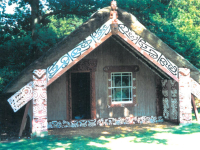See and DoMuseum of Te Wairoa
Te Wairoa - The Model Village
Historic references refer to Te Wairoa as a model Maori village. It's layout, dictated by Spencer, was based on the English village plan recommended by the Reverend Samuel Marsden. The whares or houses were laid out in streets, each having their own carefully-fenced 100 square meter garden. The establishment of Te Wairoa was slow initially owning to a land dispute between the Ngati Tuhourangi and the neighboring Ngati Rangitihi, which made life outside a pa unsafe. Peace was finally sealed in 1855 with the Tuhourangi gaining ownership of Lake Rotomahana and the surrounding lands.
THE MODEL VILLAGE
Te Wairoa was probably not laid out on a true grid as is often stated in descriptions of the village. Early photographs, drawings an visitor descriptions as well as limited archaeological data suggest the village layout was an interesting amalgam of traditional Maori and English settlement patterns. The architectural features of whares and houses in the settlement were also mixed. By the later period of occupation the settlement was a jumble of whares and houses of differing styles and materials. Observers opinions about the 'model village' differ.
The earliest photography and a painting of the site by John Kinder (January 1866) show a small settlement below Te Mu Chapel. The few whares pictured appear to be laid out in a grid fashion with rectangular garden enclosures. By 1864 at least one of the Maori occupants of Te Wairoa was living in a European-style house.












Connect with Us
Facebook YouTube Instagram Tripadvisor Blog Email